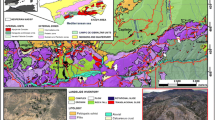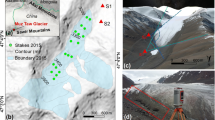Abstract
Terrestrial lidar scanning (TLS) has become a widely accepted expert tool for monitoring geohazards on bare or sparsely vegetated slopes through change detection. While trees can be an important indicator of landslide activity at a slope, vegetation is often removed or ignored when monitoring landslides with TLS. This paper explores the use of multi-temporal terrestrial lidar scanning at a slope in the Peace River valley of British Columbia to test the author’s hypothesis that tree stems in TLS data can be used to track landslide displacement and provide insight into the landslide mechanism. Six TLS datasets, each collected approximately 6 months apart, are used, and roto-translation methods are employed to determine the azimuth, plunge, and toppling angle of trees between each TLS scan. The tree displacement patterns are compared to TLS change detection results on bare-ground, and to single-point tracking techniques for extracting displacement vectors. Considerations for future applications are discussed.










Similar content being viewed by others
Availability of data and material
The data for this study is confidential and can not be shared.
Code availability
All software and code used are commercially or publicly available.
References
Abellán A, Jaboyedoff M, Oppikofer T, Vilaplana JM (2009) Detection of millimetric deformation using a terrestrial laser scanner: experiment and application to a rockfall event. Natural Hazards and Earth System Science 9:365–372
Abellán A, Oppikofer T, Jaboyedoff M, Rosser N, Lim M, Lato M (2014) Terrestrial laser scanning of rock slope instabilities. Earth Surf Proc Land 39:80–97
Besl PJ, McKay ND (1992) A method for the registration of 3D shapes. IEEE Trans Pattern Anal Mach Intell 14:239–256
Brodu N, Lague D (2012) 2D Terrestrial lidar data classification of complex natural scenes using a multi-scale dimensionality criterion: applications in geomorphology. ISPRS J Photogramm Remote Sens 68:121–134
Chen Y, Medioni G (1991) Object modeling by registration of multiple range images. IEEE conference on robotics and animation
Conner J, Olsen M (2014) Automated quantification of distributed landslide movement using circular tree trunks extracted from terrestrial laser scan data. Comput Geosci 67:31–39
Franz M, Carrea D, Abellán A, Derron M, Jaboyedoff M (2016) Use of targets to track 3D displacements in highly vegetated areas affected by landslides. Landslides 13:821–821
Gressin A, Mallet C, David N (2012) Improving 3D lidar point cloud registration using optimal neighborhood knowledge. ISPRS Annals of Photogrammetry, Remote Sensing, and the Spatial Information Sciences 1–3:111–116
Guerin A, Hantz D, Rossetti JP, Jaboyedoff M (2014) Estimating rockfall frequency in a mountain limestone cliff using a terrestrial laser scanner. Natural Hazards and Earth System Sciences Discussions 2(1):123–135
Harker RI (1996) Curved tree trunks: indicators of soil creep and other phenomena. J Geol 104:351–358
Hartman G, Clague J (2008) Quaternary stratigraphy and glacial history of the Peace River valley, northeast British Columbia. Canadian Journal of Earth Science 45:549–564
Hutchinson DJ, Lato M, Gauthier D, Kromer R, Ondercin M, van Veen M, Harrap R (2015) Applications of remote sensing techniques to managing rock slope instability risk. GeoQuebec, Quebec City Canada
Jaboyedoff M, Metzger R, Oppikofer T, Couture R, Derron MH, Locat J, Turmel D (2007) New insight techniques to analyze rock-slope relief using DEM and 3D-imaging cloud points: COLTOP-3D software. In Rock Mechanics: Meeting Society’s Challenges and Demands. Proceedings of the 1st Canada-US Rock Mechanics Symposium, Vancouver, Canada, Eberhardt E, Stead D, Morrison T (eds). Taylor and Francis: London 61–68
Jaboyedoff M, Demers D, Locat J, Locat A, Locat P, Oppikofer T, Robitaille D, Turmel D (2009) User of terrestrial laser scanning for the characterization of retrogressive landslides in sensitive clay and rotational landslides in river banks. Can Geotech J 46:1379–1390
Kromer R, Abellán A, Hutchinson DJ, Lato M, Chanut MA, Laurent D, Jaboyedoff M (2017) Automated terrestrial laser scanning with near real-time change detection – monitoring of the Séchilienne Landslide. Earth Surf Dyn 5:293–310
Lato M, Porter M, Hensold G, McDougall S, Kromer R, Gaib S (2016) Understanding landslide movement and kinematics with airborne lidar. GeoVancouver, Vancouver, Canada
Lato M, Mitchell A, Porter M, Gaib S (2017) Monitoring landslide velocity at Ten Mile slide with ground-based LiDAR. GeoOttawa. Ottawa, Canada
Lim M, Petley DN, Rosser NJ, Alison RJ, Long AJ, Pybus D (2005) Combined digital photogrammetry and time-of-flight laser scanning for monitoring cliff evolution. Photogrammetric Record 20(1):109–129
Malik I, Wistuba M, Migon P, Fajer M (2016) Activity of slow-moving landslides recorded in eccentric tree rings of Norway spruce trees (picea abies karst.) – an example from the Kamienne mts. Geochronometria 43:24–37
Mitchell A, Lato M, McDougall S, Porter M, Bale S, Watson A (2017) Regional-scale landslide and erosion monitoring utilizing airborne LiDAR change detection analysis. Geological Society of America 129th Annual Meeting, Seattle, USA
Oppikofer T, Jaboyedoff M, Blikra L, Derron MH, Metzger R (2009) Characterization and monitoring of the Åknes rockslide using terrestrial laser scanning. Nat Hazards Earth Syst Sci 9:1003–1019. https://doi.org/10.5194/nhess-9-1003-2009
Prokop A, Panholzer H (2009) Assessing the capability of terrestrial laser scanning for monitoring slow moving landslides. Natural Hazards and Earth System Science 9:1921–1928
Rosser NJ, Petley DN, Lim M, Dunning SA, Alison RJ (2005) Terrestrial laser scanning for monitoring the process of hard rock coastal cliff erosion. Q J Eng GeolHydrogeol 38(4):363–375
Rowe E, Hutchinson DJ, Kromer R (2018) An analysis of failure mechanism constraints on pre-failure rock block deformation using TLS and roto-translation methods. Landslides 15:409–421
Severin J (2004) Landslides in the Charlie Lake map sheet, Fort St. John. Master’s thesis submitted to the University of British Columbia
Stadt K, Huston C, Coates K, Feng Z, Dale M, Leiffers V (2007) Evaluation of competition and light estimation indices for predicting diameter growth in mature boreal mixed forests. Ann for Sci 64:477–490
Telling J, Lyda A, Hartzell P, Glennie C (2017) Review of earth science research using terrestrial laser scanning. Earth-Sci Rev 169:35–68
van Veen M, Hutchinson DJ, Kromer R, Lato M, Edwards T (2017) Effects of sampling interval on the frequency-magnitude relationship of rock falls detected from terrestrial laser scanning using semi-automated methods. Landslides 15(5):1579–1592
Weidner L, van Veen M, Lato M, Walton G (2021) An algorithm for measuring landslide deformation in terrestrial lidar point clouds using trees. Landslides
Acknowledgements
The authors would like to acknowledge our colleagues Siobhan Whadcoat, Scott McDougall, and Emily Rowe for their support in data collection and in providing review of the methods employed and results of this study.
Author information
Authors and Affiliations
Corresponding author
Ethics declarations
Conflict of interest
The authors declare no competing interests.
Rights and permissions
About this article
Cite this article
van Veen, M., Porter, M., Lato, M. et al. Using tree stems in multi-temporal terrestrial lidar scanning data to monitor landslides on vegetated slopes. Landslides 19, 829–840 (2022). https://doi.org/10.1007/s10346-021-01815-1
Received:
Accepted:
Published:
Issue Date:
DOI: https://doi.org/10.1007/s10346-021-01815-1




